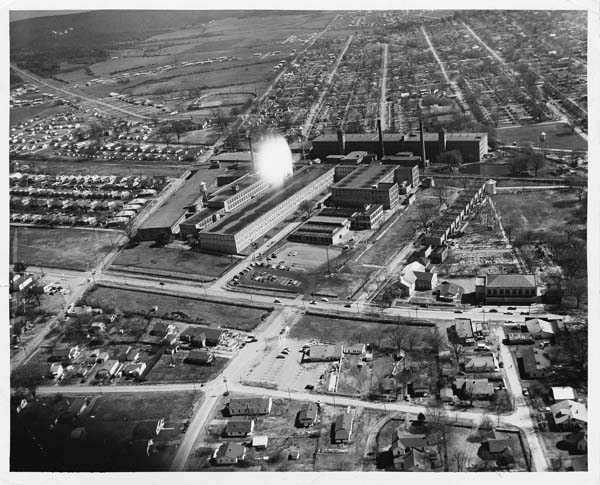
HISTORY

A Rich History
Among its rockets, technology, and engineers, Huntsville has preserved pieces of its past that tell unique stories. Visitors and locals can read pages of our history through monuments, murals, and buildings that have been standing for centuries. We are a community that values its history and finds inventive ways to share and experience it.
Huntsville’s industrial past is a chapter that involves booming textile businesses, busy mills, and workers on strike fighting for better conditions. One of these mills—Lincoln Mill—is currently undergoing a renaissance and being transformed into a modern office campus with on-site amenities for its workers and the public to enjoy. Since its beginnings in the early 1900s, Lincoln Mill has evolved alongside Huntsville. From producing cotton “duck” canvas to aiding the creation of NASA’s Lunar Rover and supporting present-day creative and tech companies, its walls have transformed to accommodate our city’s ever-changing landscape.

The Early Years
Lincoln Mill opened in 1900 under the name Madison Spinning Company. Its development took place in phases and it quickly grew to become the largest of the textile mills in Huntsville. However, the site had humble beginnings and more investors were brought in during its first five years of operation. In 1906, the mill briefly closed and reopened again in 1908 under the name Abingdon Mills.
Abingdon went bankrupt in 1918 and a new owner came to the table who would reopen the site later that year. William Lincoln Barrell, a Massachusetts textile tycoon, purchased the factory outright at an auction for $950,000. He immediately changed the name to Lincoln Mill and became the president and principal stockholder of the site. Under Barrell’s leadership, the mill hired superintendent Phillip W. Peeler of Huntsville who remained in his position until his retirement in 1953.

The Great Depression
Lincoln Mill was not immune to the effects of The Great Depression and production slowed until it halted in 1934. This is when the first of the major strikes occurred throughout the city. The United Textile Workers of the American Federation of Labor Unions organized and declared a strike that lasted from July to September of that year.
At the time, close to two-thirds of Alabama’s textile mill workers were on strike, including 5,000 workers from Huntsville’s six working mills. Of the 5,000 on strike, 1,750 were Lincoln Mill employees.
These strikes led to riots and violence throughout Huntsville. Some described the area as an “armed camp” with police patrolling the streets at all hours and standing at-the-ready should confrontations occur.

World War II
By the time World War II was at its peak, production had ramped up at the mill. The site became a manufacturing hub for cotton “duck” canvas for the United States military. Although business was regaining strength, not a lot of development or growth happened to the campus during this time. Around the mill, the Mill Village continued to add a few additions.
This rebound in business only lasted for a short while before more strikes caused an upset in the 1950s and longtime superintendent Peeler left his position.

Strikes In The 1950s
Lincoln Mill had long been under the guidance of Peeler who helped the business grow into a textile supersite. But in 1953, new management took over and additional equipment was added that made it possible to uphold the current production standards with fewer workers. This change upset many of the mill employees and it was said that the focus had changed from people to profits. Another major strike occurred in 1954.
The union filed ten grievances that included an unrealistic workload. Lincoln Mill’s management did not agree that standards were unethical but an arbitrator found favor with the workers. Another strike came along in 1955.

A Space For NASA
In 1957, businessmen saw an opportunity in the site and took steps to reopen Lincoln Mill after a renovation. It aimed to attract the Army Missile Command and Wernher von Braun to Huntsville. After its renovations were completed, the site reopened as the “Huntsville Industrial Complex” (H.I.C.) and was the founding home of Brown Engineering.
Now that the main buildings were functioning offices, the space industry utilized the site as the place where hundreds of engineers worked on Huntsville’s early rocket and missile programs. One of its purposes was to house the development of NASA’s Lunar Rover. This machine made off-road space excursion possible and allowed astronauts to bring back moon rock samples to earth—among other things.

A Devastating Fire
In the 1980s a fire ripped through the campus and destroyed the oldest buildings on site. The structures that survived—Mill No. 3 and the Dye House—were built in 1924 and are still standing today.
On a list of the largest fires in our city’s history, the fire at Lincoln Mill (H.I.C.) is at the top. But this wasn’t the end for the property. In 1982, the site’s remaining buildings were purchased by new owners and renamed the Downtown Industrial Complex.

Becoming the Lincoln Mill Office Complex
More renovations happened in 2008 to Mill No. 3 and it was home to a variety of tenants including engineering companies, government offices, educational facilities, and more. It was two years later that the property became a federal historic site and was added to the National Register of Historic Places.
Its biggest changes would happen a decade later in 2020 when Huntsville’s Crunkleton Commercial Real Estate and Lincoln Revival, LLC would take over the property for a major renovation.

Present Day
Lincoln Mill underwent its biggest transformation in 2020 and 2021. The site’s restoration introduced several new amenities that enhance its beauty and showcase the many distinctive spaces within its walls.
The Dye House—one of the remaining structures that survived the fire—houses the development’s retail, fitness, and dining concepts that benefit the campus and its tenants. Tenants include Iron Tribe Fitness, THREE15 Studio, Turbo Coffee Roasters, High Point Climbing and Fitness, Fusion Barbecue, and Heritage Kitchen + Bath.
